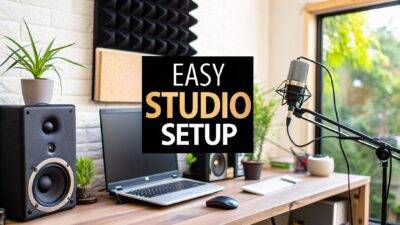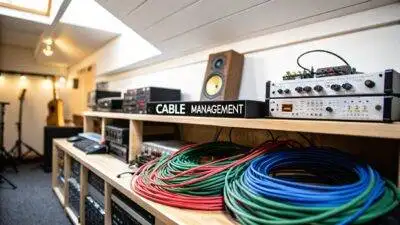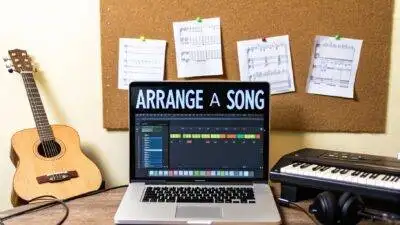Starting Your Music Journey: The Essential Gear You Actually Need
Diving into music production can feel overwhelming with endless gear options marketed as essential. This guide cuts through the noise, focusing on the core beginner music production equipment that truly forms the foundation of any home studio. We will demystify the absolute essentials, helping you invest wisely without breaking the bank or buying gear you won't use. This is about building a functional, powerful setup that empowers you to start creating professional-sounding tracks immediately.
Forget the hype and confusing jargon. This listicle provides a straightforward roadmap to your first home studio. We will break down exactly what each piece of equipment does, why it's a crucial part of the creative process, and offer specific, industry-standard recommendations. You will learn not just what to buy, but how these components work together to capture your ideas and transform them into finished songs. Our focus is on practical application, ensuring you understand how to connect and use each item effectively from day one. By the end of this guide, you'll have a clear shopping list and the confidence to assemble a studio that grows with you on your production journey.
1. Audio Interface – Focusrite Scarlett Solo/2i2
An audio interface is the central nervous system of any home studio, serving as the critical bridge between your analog sound sources (like microphones and guitars) and your computer's digital world. It converts your performances into a format your Digital Audio Workstation (DAW) can understand and plays back your mix through your headphones or studio monitors. For anyone serious about making music, it is the most essential piece of beginner music production equipment you will purchase.
Why the Focusrite Scarlett?
The Focusrite Scarlett series, particularly the Solo and 2i2 models, has become the de facto standard for entry-level producers for good reason. They offer clean, low-noise preamps, robust build quality, and near-universal plug-and-play compatibility. The "Air" mode, a feature on newer generations, emulates Focusrite's classic ISA preamps, adding a touch of high-end brightness and clarity to vocals and acoustic instruments. This feature alone provides significant value, giving beginners access to a professional sound without needing expensive outboard gear.
The choice between the Solo and 2i2 comes down to your immediate needs. The Solo, with one microphone input and one instrument input, is perfect for singer-songwriters or vocalists recording one source at a time. The 2i2 provides two combination inputs, allowing you to record two microphones or a stereo source simultaneously, offering more flexibility for future growth.
This bar chart highlights the key technical specifications that determine recording quality.
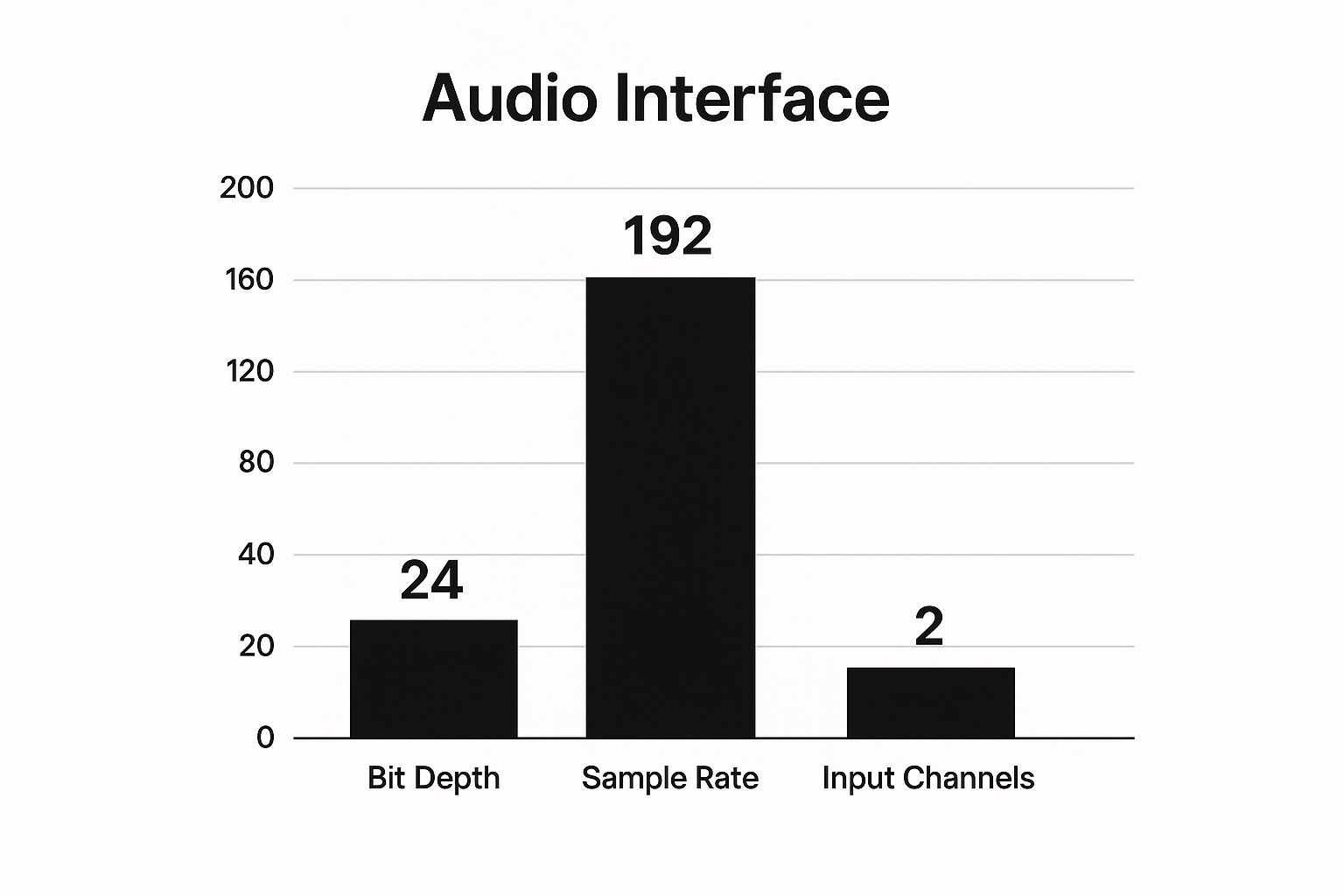
The chart demonstrates that even at an entry-level price, the Scarlett provides professional-grade 24-bit depth and a high 192 kHz sample rate, ensuring your recordings capture immense detail. You can learn more by exploring a detailed breakdown of the best audio interface for beginners on chordx.io. Use the direct monitoring button to listen to your input signal directly, eliminating distracting latency during recording.
2. Digital Audio Workstation (DAW) – Ableton Live Lite/Reaper
If the audio interface is your studio's nervous system, the Digital Audio Workstation (DAW) is its brain. This software is where all the magic happens: recording audio, arranging MIDI notes, editing performances, mixing tracks, and adding effects. It is the virtual environment where your musical ideas are built, shaped, and finalized. Choosing the right one is a crucial step when assembling your beginner music production equipment, as it will define your entire workflow.
Why Ableton Live Lite or Reaper?
While there are many DAWs on the market, Ableton Live Lite and Reaper stand out for beginners due to their powerful features and accessible entry points. Ableton Live, famously used by producers like Deadmau5, is renowned for its Session View, a non-linear, clip-based workflow that is incredible for brainstorming ideas, live performance, and electronic music creation. The Lite version, often bundled free with hardware like the Focusrite Scarlett, offers a fantastic introduction to this creative process.
Reaper, on the other hand, offers a fully-featured, uncrippled 60-day trial, after which a personal license is incredibly affordable. It is known for its extreme customizability, low CPU usage, and robust, traditional workflow favored by many audio engineers and film composers. Starting with one of these gives you access to professional-grade tools without a hefty initial investment. Focusing on learning one DAW deeply is far more productive than jumping between different programs.
The best approach is to start with official tutorials and learn essential keyboard shortcuts early to build efficient habits. While the options we have mentioned are fantastic starting points, you can explore other powerful options in this guide to the best free DAWs on chordx.io.
3. Studio Monitor Headphones – Audio-Technica ATH-M40x/M50x
While studio monitor speakers are ideal, they aren't always practical for a beginner's space or budget. This is where high-quality studio monitor headphones become indispensable. They are not the same as consumer headphones, which often color the sound to make it more pleasing. Instead, studio headphones are designed to provide a flat, accurate frequency response, allowing you to hear your mix precisely as it is, warts and all. This makes them a critical piece of beginner music production equipment for making accurate mixing and mastering decisions.
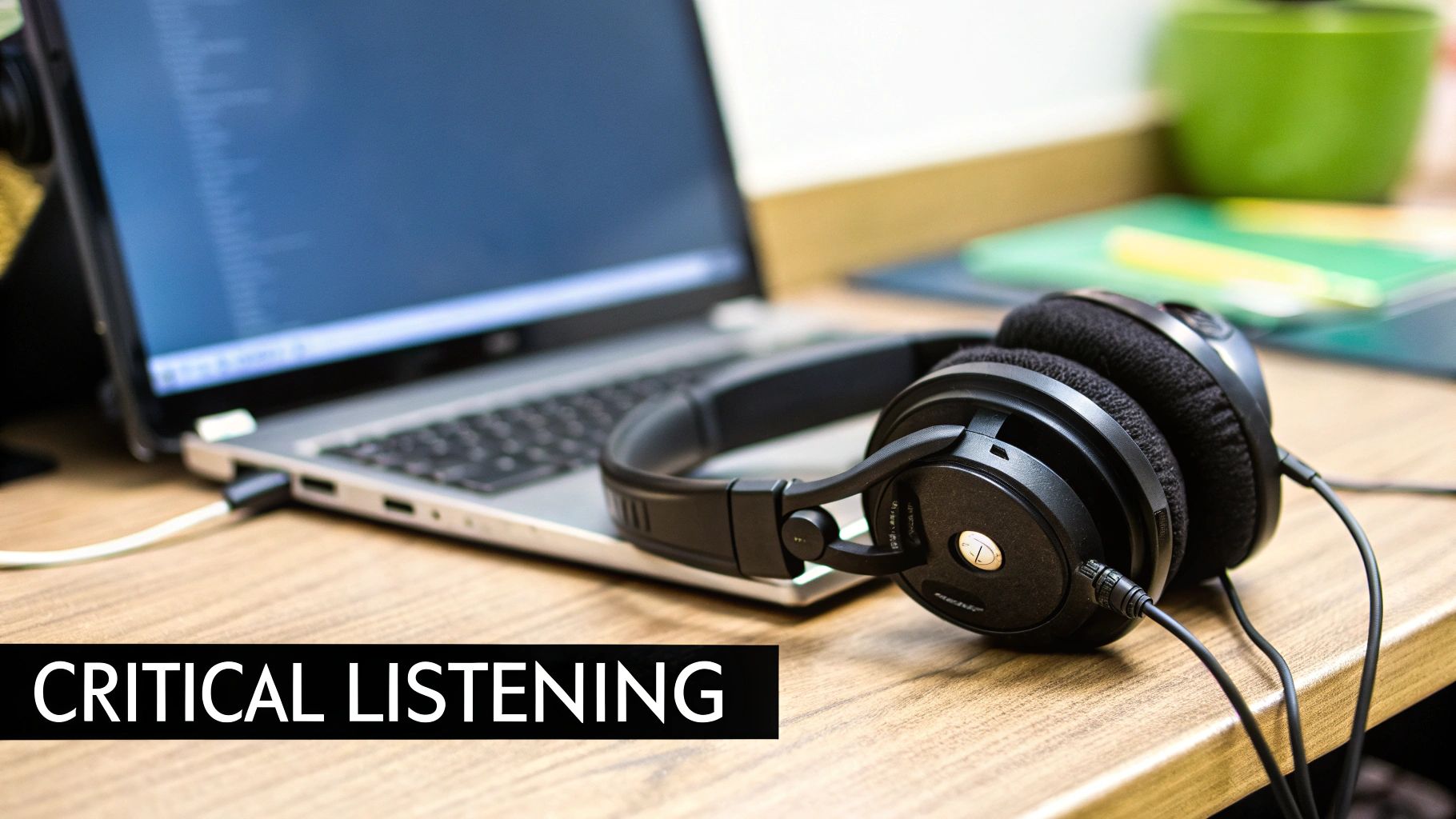
Why the Audio-Technica ATH-M Series?
The Audio-Technica M-series, specifically the ATH-M40x and ATH-M50x, has earned its place as a studio staple for its exceptional balance of performance, durability, and affordability. They provide the sonic detail needed for critical listening, from identifying subtle clicks and pops to judging the balance of your low-end frequencies. Their closed-back design offers excellent sound isolation, preventing microphone bleed during recording and helping you focus on your mix without outside distractions. This isolation is crucial when recording vocals or acoustic instruments in the same room as your setup.
The primary difference lies in their sound signature. The M40x is known for its exceptionally flat and neutral response, making it a purist's choice for analytical mixing. The M50x, while still very accurate, has a slightly more pronounced low-end and high-end, which many producers find more engaging and closer to how music sounds on consumer systems. This makes the M50x a fantastic all-rounder for both tracking and mixing. Both models feature swiveling earcups and a collapsible design, making them practical for storage and travel. To avoid ear fatigue and maintain perspective, it is wise to take regular listening breaks and reference your mix at low volumes.
4. USB MIDI Keyboard Controller – Akai MPK Mini/Arturia MiniLab
While you can technically compose music using just your computer keyboard and mouse, a MIDI keyboard controller unlocks a level of expression and workflow efficiency that is impossible to achieve otherwise. It doesn't produce sound on its own; instead, it sends MIDI (Musical Instrument Digital Interface) data to your computer, allowing you to play virtual instruments, program drum beats, and automate parameters in your DAW with physical, tactile controls. For any aspiring producer, it’s a critical piece of beginner music production equipment that makes the creative process feel more like playing an instrument and less like data entry.
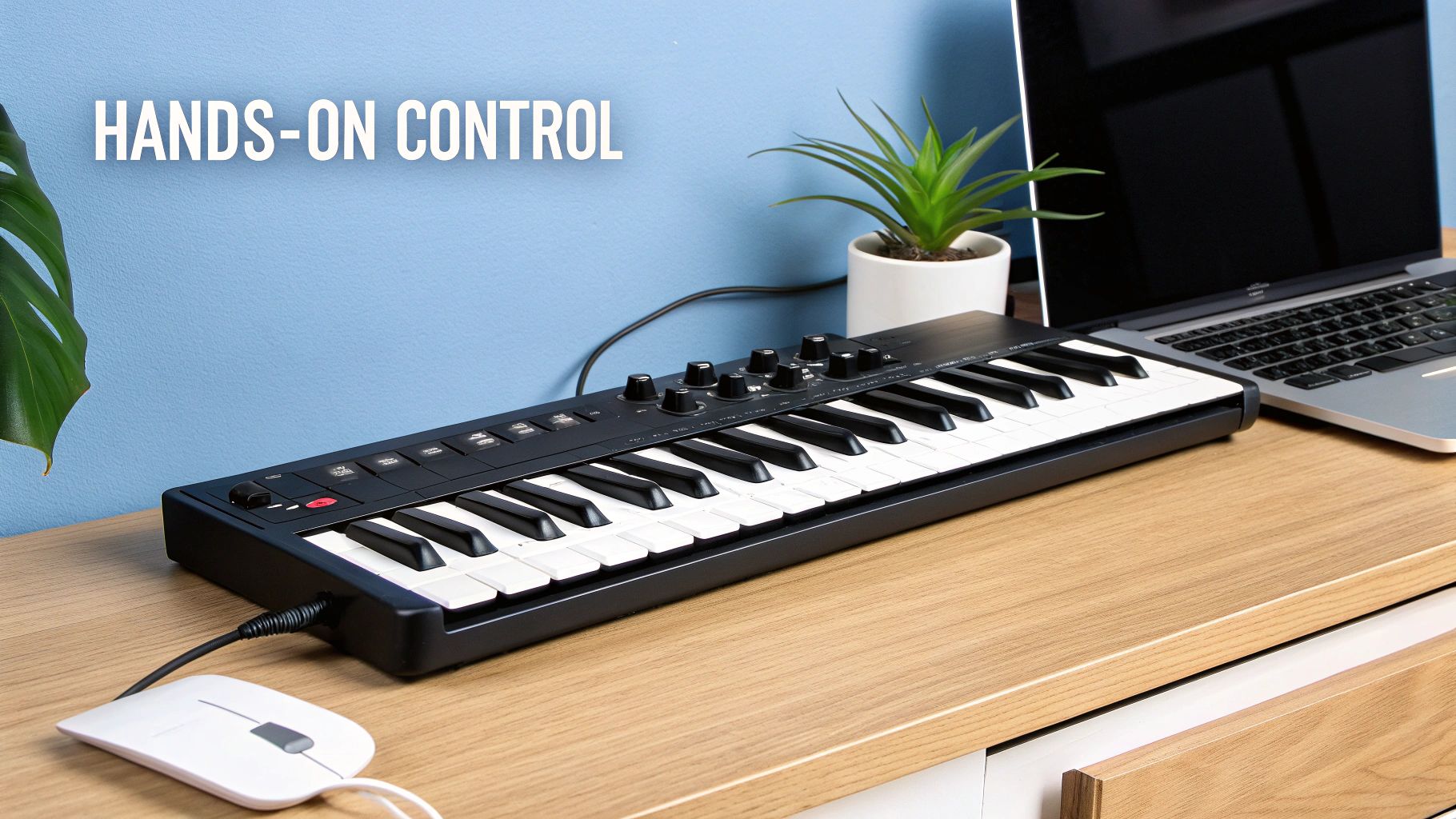
Why the Akai MPK Mini or Arturia MiniLab?
The Akai MPK Mini and Arturia MiniLab are titans in the compact controller space, dominating the setups of bedroom producers and traveling musicians. Their popularity stems from packing an immense amount of functionality into a small, affordable footprint. Both offer 25 velocity-sensitive mini keys, assignable knobs for tweaking plugin parameters, and drum pads for finger-drumming. This combination provides a hands-on connection to your software that is essential for developing musical ideas quickly. Akai's pads are often praised for their feel, borrowing from the legendary MPC series, while Arturia's responsive touch strips for pitch and modulation offer a modern alternative to traditional wheels.
The choice between them often comes down to the bundled software and specific control layout. The MPK Mini is a staple in hip-hop and electronic music, known for its iconic red joystick and straightforward workflow. The Arturia MiniLab, on the other hand, comes with a vast library of classic synth sounds from its Analog Lab software, making it a fantastic value for those looking to build their sound palette. Regardless of your choice, learning to map the knobs and pads to your most-used functions will dramatically speed up your production process and unlock new creative possibilities.
5. Condenser Microphone – Audio-Technica AT2020/Rode PodMic
A quality microphone is your primary tool for capturing the soul of a performance, whether it's a lead vocal, the strum of an acoustic guitar, or spoken word for a podcast. It translates sound waves into electrical signals, and its quality directly impacts the clarity, detail, and emotional weight of your recordings. For anyone recording real-world sound, a dedicated microphone is non-negotiable beginner music production equipment.
Why the AT2020 or Rode PodMic?
This recommendation presents two distinct but equally valuable paths. The Audio-Technica AT2020 is a large-diaphragm condenser microphone, the workhorse of home studios globally. It excels at capturing detail and nuance, making it ideal for expressive vocals and acoustic instruments. Its sensitivity picks up the subtle textures that bring a recording to life. A key implementation tip is to always use a pop filter to tame plosives (harsh 'p' and 'b' sounds) and to record in a space with minimal reflections, as its sensitivity will capture room noise.
Alternatively, the Rode PodMic is a dynamic microphone optimized for broadcast and voice work. It's less sensitive to background noise and room acoustics, making it a forgiving choice for beginners in untreated spaces. Its tailored frequency response gives vocals a rich, professional broadcast-quality sound right out of the box, perfect for podcasters, streamers, and vocalists seeking a focused, powerful tone. Choosing between them depends on your primary use case: the AT2020 for detailed, sensitive studio work, and the PodMic for robust, forgiving voice recording.
6. Studio Monitor Speakers – JBL 305P MkII/KRK Rokit 5 G4
While headphones are essential for detailed listening and recording, studio monitor speakers are non-negotiable for understanding how your mix translates in a real space. Unlike consumer speakers that often color the sound to make it more pleasing, studio monitors aim for a "flat" frequency response. This honest, uncolored sound reproduction is crucial for making accurate mixing decisions about EQ, compression, and stereo imaging. They reveal flaws in your mix that headphones might hide, making them a cornerstone piece of beginner music production equipment for anyone serious about releasing professional-sounding tracks.
Why the JBL 305P MkII or KRK Rokit 5 G4?
The JBL 305P MkII and KRK Rokit 5 G4 are two of the most popular and trusted entry-level monitors for a reason. The JBLs are renowned for their surprisingly wide stereo image, thanks to the patented Image Control Waveguide derived from their high-end professional monitors. This technology helps create a broad "sweet spot," meaning the mix sounds consistent even if you move your head slightly. This forgiving nature is perfect for beginners still learning proper listening posture.
Conversely, the KRK Rokit 5 G4 is a favorite, especially in electronic and hip-hop genres, for its defined low-end response and a forward-sounding mid-range. The newer G4 series includes a built-in DSP-driven graphic EQ with an LCD screen, allowing you to visually adjust the speaker's response to better match your room's acoustics. This feature offers a level of professional room correction rarely found at this price point. Your choice depends on your preference: JBL for its expansive stereo field and clarity, or KRK for its powerful low-end and advanced room-tuning capabilities. Both will dramatically improve your ability to produce a mix that sounds great everywhere.
7. Acoustic Treatment – Auralex Foam/Moving Blankets
Acoustic treatment is arguably one of the most overlooked yet impactful investments for a home studio. It isn't gear in the traditional sense, but controlling your room's sound is essential for creating a reliable listening environment. Untreated spaces, like a typical bedroom, are full of hard, reflective surfaces that cause sound waves to bounce around, creating echo, flutter, and problematic frequency buildups. This distorts what you hear from your monitors, making it impossible to mix accurately. Properly placed acoustic treatment is a non-negotiable piece of beginner music production equipment for anyone serious about translation, ensuring your mixes sound good everywhere, not just in your room.
Why Start with Basic Absorption?
For beginners, the goal isn't to build a perfectly tuned, professional studio but to tame the most severe acoustic problems. This is where accessible solutions like Auralex foam panels or even thick moving blankets come in. They work through absorption, converting sound wave energy into a tiny amount of heat, which stops the sound from reflecting back into the room. Placing these materials at key points dramatically improves monitoring accuracy and clarifies recordings, especially for vocals and acoustic instruments.
The key is strategic placement, not total coverage. You should focus on the "first reflection points," which are the spots on the walls, ceiling, and floor where sound from your monitors would bounce directly to your ears. A simple "mirror trick" can help you find these. While professional foam like Auralex is designed for this purpose, a budget-conscious beginner can achieve a significant improvement using heavy moving blankets hung on walls or draped over mic stands. This initial step of taming reflections is more critical than buying a more expensive microphone or monitors.
You can dive deeper into effective strategies by reading about acoustic treatment for home studios on chordx.io. Remember, even minimal treatment is a massive leap forward from an untreated room.
8. Portable Recorder – Zoom H1n/H4n Pro
While your studio is the primary creative space, inspiration doesn't always strike when you're tethered to a computer. A portable recorder is a powerful tool for capturing high-quality audio anywhere, making it a surprisingly versatile piece of beginner music production equipment. It’s perfect for recording song ideas on the fly, capturing unique sound effects from the real world (field recording), or even serving as a backup recorder for important sessions.
Why the Zoom H1n/H4n Pro?
Zoom has dominated the portable recorder market by offering professional features in a compact and affordable package. The built-in X/Y stereo microphones are a key feature, providing a clear and immersive stereo image right out of the box. This is ideal for capturing the natural sound of an acoustic guitar, a piano, or the ambiance of a room without needing a complex microphone setup. These recorders save directly to an SD card, completely untethering you from your main production rig.
The choice between the H1n and the H4n Pro depends on your needs. The H1n is incredibly simple and compact, perfect for quick sketches, interviews, or basic field recording. The H4n Pro is a more advanced option, featuring two combination XLR/TRS inputs that allow you to connect external professional microphones, effectively turning it into a mobile audio interface. This flexibility is invaluable for artists who want to record band practices or create high-quality demos outside the studio. Careful monitoring of your recording levels is crucial to avoid digital clipping, an irreversible form of distortion. Always record a minute of "room tone" – the silent ambiance of your space – to help with noise reduction in post-production.
Beginner Music Production Gear Comparison
| Item | Core Features | User Experience ★ | Value Proposition 💰 | Target Audience 👥 | Unique Selling Points ✨ | Price Range 💰 |
|---|---|---|---|---|---|---|
| Audio Interface – Focusrite Scarlett Solo/2i2 | 24-bit/192kHz, Phantom power, Direct monitoring | ★★★★☆ Reliable & portable | ★★★★ Budget pro-quality | Beginners, Home studios | Plug-and-play, bundled software | $120-200 |
| Digital Audio Workstation (DAW) – Ableton Live Lite/Reaper | Multitrack, MIDI, Virtual instruments | ★★★★☆ Pro features, learning curve | ★★★★ Affordable pro licenses | Electronic producers, composers | Ableton’s workflow, Reaper’s license | $60-100 / Free-$100 |
| Studio Monitor Headphones – Audio-Technica ATH-M40x/M50x | Closed-back, flat response, swiveling cups | ★★★★ Accurate & comfortable | ★★★★ Affordable pro quality | Producers, mixers | Durable, widely supported | $99-149 |
| USB MIDI Keyboard Controller – Akai MPK Mini/Arturia MiniLab | 25 keys, assignable controls, USB powered | ★★★★ Compact & intuitive | ★★★★ Great value & software | Bedroom producers, mobile | Portable, all-in-one controllers | $119-149 |
| Condenser Microphone – Audio-Technica AT2020/Rode PodMic | Large diaphragm, cardioid, low noise | ★★★★ Professional sound | ★★★★ Versatile & durable | Podcasters, vocalists | Studio-grade quality, XLR connectivity | $99-199 |
| Studio Monitor Speakers – JBL 305P MkII/KRK Rokit 5 G4 | Bi-amped, tailored freq response | ★★★★ Accurate mixing | ★★★★ Trusted pro gear | Mix engineers, producers | Room correction, powerful amp | $149-199 each |
| Acoustic Treatment – Auralex Foam/Moving Blankets | High freq absorption, fire-resistant | ★★★★ Immediate room improvement | ★★★☆ Inexpensive DIY solution | Home studios, podcasters | Easy install, effective absorption | $50-500 |
| Portable Recorder – Zoom H1n/H4n Pro | 96kHz/24-bit, built-in mics, long battery | ★★★★ Portable & simple | ★★★★ Affordable pro recording | Field recorders, singer-songwriters | Compact, multiple recording modes | $99-299 |
Bringing It All Together: Your Next Steps in Music Production
Navigating the world of beginner music production equipment can feel overwhelming, but as we've explored, the journey starts with a few foundational pieces. This guide has laid out a clear roadmap, moving from the non-negotiable core of your setup to the specialized tools that will shape your unique sound. We've dissected everything from the central nervous system of your studio, the audio interface, to the creative gateways provided by MIDI keyboards and the crucial feedback loop offered by quality headphones and monitors.
The most critical takeaway is not to buy everything at once. Instead, embrace a phased approach. Your initial investment should be laser-focused on the absolute essentials: a reliable audio interface like the Focusrite Scarlett, a versatile DAW such as Ableton Live Lite or Reaper, and a pair of honest studio headphones like the Audio-Technica ATH-M40x. This core trio is the entire foundation upon which every future production will be built. Mastering this simple setup is far more valuable than owning a room full of gear you barely understand.
Your Actionable Path Forward
Once you are comfortable with the basics, your next steps should be dictated entirely by your creative goals. Your workflow will reveal what you need next.
- If you are a vocalist or instrumentalist: Your immediate priority should be a quality condenser microphone, like the Audio-Technica AT2020. This is your primary tool for capturing clean, professional-grade audio at the source.
- If you are a beat maker or electronic producer: A MIDI keyboard controller, such as the Akai MPK Mini, becomes your next logical purchase. It unlocks a hands-on, expressive way to program drums, write melodies, and control virtual instruments.
- If you are mixing and mastering: Before you invest in more plugins, consider studio monitors and basic acoustic treatment. This step is about refining your listening environment, which is arguably the most important "instrument" for achieving a polished, translatable mix.
The Gear is a Tool, Not the Talent
Remember, the equipment discussed in this article, from the simplest portable recorder to the most advanced DAW, are just instruments. They are conduits for your creativity, not substitutes for it. The goal is to achieve fluency with your chosen gear so it becomes an extension of your musical ideas, not a barrier to them. The best producers can create compelling music with a minimal setup because they have invested the time to master their tools and, more importantly, to train their ears.
Focus on the fundamentals: learn your DAW inside and out, practice critical listening on your headphones, and understand the principles of gain staging with your interface. This knowledge is transferable and will serve you far longer than any single piece of hardware. Your journey into music production is a marathon, not a sprint. Build your studio thoughtfully, piece by piece, as your skills and needs evolve.
As you begin to master your beginner music production equipment, you will want to accelerate your workflow with smarter tools. ChordX is designed to do just that, offering AI-powered chord progression generation and melody ideas to overcome creative blocks and inspire your next track. It integrates seamlessly with your new setup, helping you transform basic ideas into complex arrangements. Explore ChordX to see how you can elevate your songwriting and production from the very start.

